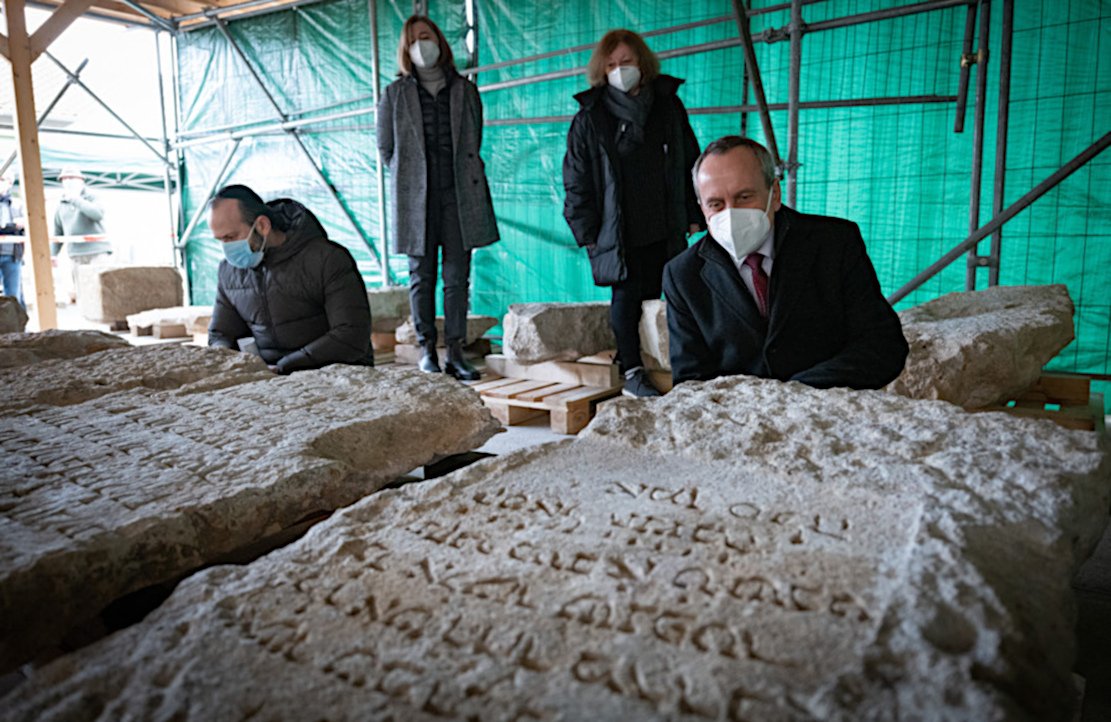Archaeologists have discovered 18 tombstones for a medieval Jew in the ancient town of Mainz. It is possible that the stones were stolen from the Jewish cemetery in Medina after the pogroms of the late Middle Ages and were built into a wall as filler material. It is thus evidence of the important historical legacy of the Jews in the region and, at the same time, the effects of the hostility to which these people in Germany and Europe were repeatedly exposed.
As is often the case, construction work summoned archaeologists to the square: stones appeared with Hebrew figures on Rheinstrasse in the east of the Old City of Mainz.
In November 2020, state archeology in Mainz uncovered 18 samples of these discoveries. They are now stored in a warehouse of the General Directorate of Cultural Heritage in Mainz-Breitzenheim, where their inscriptions are currently scientifically recorded. However, what the tombstones are about is mainly evident already, according to reports by the Department of Science, Additional Education and Culture of the Rhineland-Palatinate (MWWK): It was once stolen from the Jewish cemetery in Mainz, which was founded in the 11th century, and is used for other purposes.
Installed in the wall
“Tombstones were built into a wall on the bank of the Rhine in the 15th century, at the latest in the first half of the 16th century,” explains Marion Wittier of the state archeology department in Mainz. According to her, the massacres of 1438 may have been the cause of the destruction of the tombs. “The discoveries are traces of Mainz’s important Jewish history and also shed light on the dark stages of history when Jewish graves were desecrated here and in many other cities in Germany and Europe and tombstones were reused as building material,” Whitier said. A more detailed analysis of the inscriptions should now clarify whether the newly discovered Mainz tombstones also include known medieval Jewish tombstones, says the archaeologist.
As reported by MWWK, Mainz, along with Speyer and the Worms, formed an important center of Jewish life throughout Europe in the Middle Ages. The union of these societies in the Middle Ages was known as “shum”. The cemetery in Mainz, also known as “Godensand”, is the oldest Jewish burial place in Germany and at the same time the largest cemetery from the period up to 1300. The oldest Jewish gravestone dated Central Europe from 1049 – is now in the Landesmuseum Mainz. The cemetery, preserved in parts to this day, was of far-reaching significance: the basic principles of planning and design of graves influenced Jewish burial sites throughout Central Europe, MWWK writes.
More monuments of Jewish history
However, tombstones from an ancient Jewish cemetery that have now been discovered are not the first built copies to reappear. As early as 1926, several medieval tombstones previously found during construction were placed in a memorial cemetery, which are still in the area of the old cemetery. In 1926, in order to celebrate the later installation, gravestones were not intentionally directed eastward, which is common in Jewish cemeteries. On the other hand, their preparation follows a serpentine path and was intended to remind the deceased in a special way.
“Tombstones that have now been rediscovered are other centuries-old testimonies of Jewish roots and traditions in Mainz. We will now explain with the Jewish community how we will deal with the finds,” says Culture Minister Konrad Wolf. Rabbi of the Jewish community Mainz Aharon Wernickowski says: “The gravestones that have been found are undoubtedly of great historical and religious significance for the development of the Jewish history of Mainz in the Middle Ages.” “These tombstones can also represent the fact that Jewish life in Mainz not only has a history, but it must also have a future,” adds Joanna and Rublowska-Neil, vice president of the Mainz Jewish community.
Those: The Ministry of Science, Additional Education and Culture of the State of Rhineland-Palatinate

“Alcohol buff. Troublemaker. Introvert. Student. Social media lover. Web ninja. Bacon fan. Reader.”







More Stories
Science: The percentage of women in mint topics rises to a third
Newly appointed Science, Research and Innovation Council
Asparagus with Salmon and Avocado: A slightly different asparagus dish